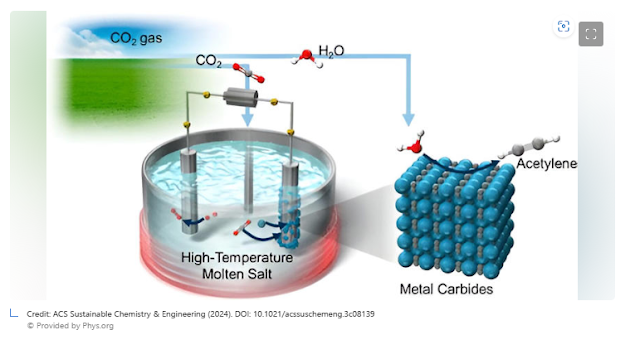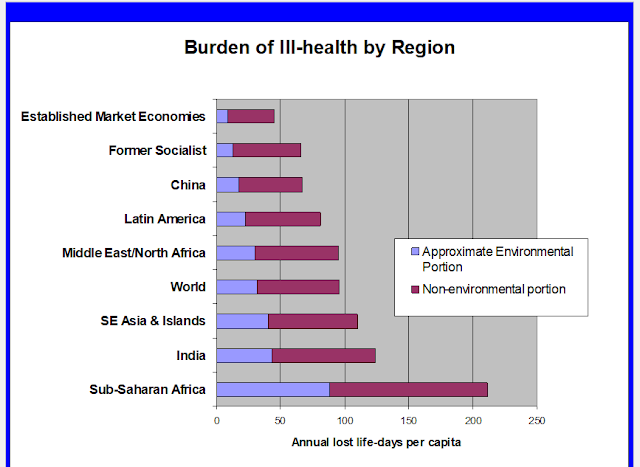The utilization
of captured carbon is an important component of decarbonization. Currently, the
vast majority of utilized captured CO2 is used for enhanced oil recovery. That
is about to change according to forecasts. Due to tech advancements and generous
incentives from the Bipartisan Infrastructure Bill and the IRA the U.S. is on
the verge of increasing the utilization of captured CO2. The DOE’s Office of
Fossil Energy and Carbon Management developed a grant program in 2022, their Carbon
Utilization Program, that “is designed to establish a grant program for
state and local governments to procure and use products derived from captured
carbon oxides.” Initial funding was $310 million.
The graph below
shows the different carbon utilization possibilities. Aquaculture can utilize
carbon in biomass to yield algae through dewatering, to yield biochar, biogas/syngas,
or biocrude through conversion, or to yield lipids, proteins, or carbohydrates
through fractionation. Through carbonization, carbon can be converted to
inorganic materials which can yield biocarbonates, carbonate aggregates, carbon
cements, and other inorganic materials and chemicals. Carbon can be converted
into fuels and organic chemicals via two methods: biotic synthesis and abiotic
synthesis. Biotic synthesis can yield neat fuels and blendstocks, commodity,
specialty, and fine chemicals, and emerging biochemicals. Abiotic synthesis can
yield comm oddity, specialty, and fine chemicals through carbon insertion. Through
carbon coupling abiotic synthesis can yield C2 basic chemicals, graphite, and
carbon. Through C1 reforming abiotic synthesis can yield CO, syngas, and C1
basic chemicals. Captured carbon can also be used as a working fluid to provide
services, mainly for improved resource recovery. Crude oil, natural gas, coalbed
methane, groundwater, wastewater, and geothermal energy can all utilize CO2 as
a working fluid to improve recoveries.
IDTechEx forecasts
that the percentage of captured carbon used for enhanced oil recovery will drop
from the current 90+% to about 50% by 2044. That does not mean that enhanced
oil recovery won’t increase, just that it will be less of the total share of captured
carbon utilized. They also forecast that CO2 conversion to fuels and to
building materials, in roughly equal measure will dominate the new uses for captured
carbon as the graph below shows. Conversion to chemicals and biological
products will make up a much smaller share.
IDTechEx predicts that by 2044,
utilization of waste CO2 will reach 800 Mt, creating over 3,000 Mt of useful
products. Of course, CO2 converted to fuels and some chemicals and other
products will be burned or consumed, re-releasing the captured CO2 to the
atmosphere, but without any new CO2 being generated. Other products like CO2-imbued
building materials and biochar will be sequestered for a long time. CO2
sequestration into deep saline reservoirs offers the longest-term storage. Government
requirements, mandates, new regulatory rules, and incentives are expected to
help fuels and building materials to utilize more captured CO2. They also note
that CO2 utilization for crop enhancement in greenhouses is expected to grow as
new CO2 pipelines are constructed and filled. The graph below shows emerging applications
for the utilization of captured CO2. They also note that some chemicals such as CO2-derived
polycarbonates are already produced commercially but they do not require very
much CO2 to make, and that chemicals that require non-reductive pathways are
the most promising due to a smaller energy demand.
A paper published
in November 2019 in Nature addressed the technological and economic prospects
of CO2 utilization and removal. The authors also pointed out some co-benefits
od certain utilization pathways. One example is land-based CO2 sequestration
into products like biochar can increase agricultural yields and soil health. Another
example is that the use of carbon in construction materials can reduce the
amounts of other materials required as well as offering a fairly permanent
storage solution. The paper provides ten potential utilization pathways that can
be scaled up to utilize over 0.5 gigatons of CO2 annually each. The ten
pathways are shown in the graphic below of stocks and net flows of CO2 in the
environment and in the table below:
CO2 flows from the different types of utilization and
removal are shown below.
The last two graphs from the paper address economics and breakeven costs for
2019. Since then, some costs likely have risen due to inflation and higher
borrowing costs but that is likely to have been more than offset by new
subsidies and incentives as well as some technological improvements. The
authors mention a few possible tech improvements that could decrease costs: “The
emissions-reduction potentials of the three cycling pathways would be
facilitated by declines in the costs of CO2 capture. New sorbents could reduce
the cost of energy-intensive separation of CO2 from flue gases and industrial
streams.” They emphasize that new materials and catalysts can be employed
to decrease the costs of CO2 utilization.
A summary for
a CO2 utilization market report by Research and Markets describes the scope of
the report: “Multiple product opportunity areas are examined including
synthetic hydrocarbon fuels and feedstocks, polycarbonates, polyols, industrial
gases, enhanced oil recovery, yield boosting technologies, carbon nanomaterials, and sustainable building products.” The report also addresses regional outlooks
for carbon utilization, market challenges, drivers, and industry players.
I wrote about
carbon utilization in my 2022 book: Natural Gas and Decarbonization.
There I focused on some current projects as well as the DOE-NETL’s utilization
projects, about three-quarters of which were focused on conversion to fuels and
chemicals. Only five, or one-eight of the projects were focused on mineral
carbonization to produce building products like CO2-imbued concrete and other
composite construction materials. I also wrote about the possibility of developing
a carbon nanotube and fibers industry to replace the use of metals, which could
make products lighter and more durable. The idea was developed by Rice
University carbon materials expert Matteo Pasquali. Along with cost, the big
hurdle is developing manufacturing capacity for scale-up that can compete with
metals manufacturing. Replacing metals with carbon nanomaterials can reduce
carbon emissions significantly if such an industry is developed. This is
because sources of carbon such as hydrocarbons in the earth are much more
concentrated than metal ores. While conversion to chemicals won’t utilize as
much carbon as conversion to fuels, there are many chemicals into which CO2 can
be converted. I wrote about Lanza Tech’s biological conversion of algae biomass
into sustainable jet fuel and their conversion of ethanol into polyester.
Today,
I read about new research to convert CO2 and water into acetylene gas (C2H2),
which has many uses including in welding, industrial cutting, metal hardening,
heat treatments, and other industrial processes. The idea is to use captured
CO2 and water as feedstock rather than fossil fuels. The process requires the
use of high-temperature molten salts. The images below show some of the
details:
Another major
obstacle to the cost-effective conversion of CO2 into useful products via
electrochemical conversion is the breakdown of catalysts under standard
operating conditions. Researchers at McMaster University recently published a
paper in Nature that used electron microscopy to see within the conversion
process to determine how the catalysts break down and to inform strategies that
could extend the operational lifetimes of these catalysts, particularly palladium-based
catalysts. Just seeing the process at nanoscale is a key development for future
improvement. An understanding of catalyst degradation can lead to increasing
the stability and operational lifetime of the catalysts.
References:
Researchers
reveal elusive bottleneck holding back global effort to convert carbon dioxide
waste into usable products. Science X staff. Phys.org. February 2024. Researchers reveal elusive bottleneck
holding back global effort to convert carbon dioxide waste into usable products
(phys.org)
Impact
of palladium/palladium hydride conversion on electrochemical CO2 reduction via
in-situ transmission electron microscopy and diffraction. Ahmed M. Abdellah,
Fatma Ismail, Oliver W. Siig, Jie Yang, Carmen M. Andrei, Liza-Anastasia
DiCecco, Amirhossein Rakhsha, Kholoud E. Salem, Kathryn Grandfield, Nabil
Bassim, Robert Black, Georg Kastlunger, Leyla Soleymani & Drew Higgins.
Nature Communications volume 15, Article number: 938. January 31, 2024. Impact of palladium/palladium hydride
conversion on electrochemical CO2 reduction via in-situ transmission electron
microscopy and diffraction | Nature Communications
Carbon
Utilization Program. U.S. Dept. of Energy. Office of Fossil Energy and Carbon
Management. Carbon
Utilization Program | Department of Energy
About
Carbon Utilization. U.S. Dept. of Energy. National Energy Technology
Laboratory. About
Carbon Utilization | netl.doe.gov
Utilization
of Captured CO2 to Reach 800 Mt by 2044, Finds IDTechEx. IDTechEx. January 23,
2024. Utilization
of Captured CO2 to Reach 800 Mt by 2044, Finds IDTechEx (prnewswire.com)
Carbon
Dioxide Utilization 2024-2044: Technologies, Market Forecasts, and Players. Eve
Pope. IDTechex. January 2024. Carbon
Dioxide Utilization 2024-2044: Technologies, Market Forecasts, and Players:
IDTechEx
Carbon
Capture, Utilization & Storage Technologies Market Outlook 2024 : Trends,
Challenges and Key Suppliers Analysis By 2031. Fashion Trend Segment. LinkedIn.
March 8, 2024. (21)
Carbon Capture, Utilization & Storage Technologies Market Outlook 2024 :
Trends, Challenges and Key Suppliers Analysis By 2031 | LinkedIn
Report is by 360 Research Reports with link below. https://www.360researchreports.com/enquiry/request-sample/20311849
Carbon
Dioxide (CO2) Utilization Global Market Report 2024-2045: Emerging Concepts
Around Mineralization Pathways for Carbon Removal. PR Newswire. January 25,
2024. Carbon
Dioxide (CO2) Utilization Global Market Report 2024-2045: Emerging Concepts
Around Mineralization Pathways for Carbon Removal (yahoo.com)
Discover
20 Startups advancing Carbon Capture Utilization & Storage (2024). Startus
Insights. 20
Startups advancing Carbon Capture Utilization & Storage (2024)
(startus-insights.com)
The
technological and economic prospects for CO2 utilization and removal. Cameron
Hepburn, Ella Adlen, John Beddington, Emily A. Carter, Sabine Fuss, Niall Mac
Dowell, Jan C. Minx, Pete Smith & Charlotte K. Williams. Nature volume 575,
pages87–97 (2019). The
technological and economic prospects for CO2 utilization and removal | Nature
Natural
Gas and Decarbonization: Key Component and Enabler of the Lower Carbon, Reasonable
Cost Energy Systems of the Future: Strategies for the 2020s and Beyond. Kent C.
Stewart. Amazon Publishing 2022.
Advancing
towards sustainability: Turning carbon dioxide and water into acetylene.
Science X Staff. Phys.org. March 27, 2024. Advancing
towards sustainability: Turning carbon dioxide and water into acetylene
(msn.com)




































